SPAD S.XIII
| S.XIII | |
|---|---|
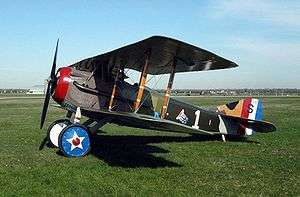 | |
| SPAD S.XIII in the colors and markings of Capt. Eddie Rickenbacker, U.S. 94th Aero Squadron. This aircraft is on display at the National Museum of the U.S. Air Force near Dayton, Ohio. | |
| Role | biplane fighter |
| National origin | France |
| Manufacturer | SPAD |
| Designer | Louis Béchéreau |
| First flight | 4 April 1917[1] |
| Primary users | Aéronautique Militaire Royal Flying Corps (Royal Air Force from April 1918) US Army Air Service |
| Number built | 8472 |
The SPAD S.XIII was a French biplane fighter aircraft of World War I, developed by Société Pour L'Aviation et ses Dérivés (SPAD) from the earlier highly successful SPAD S.VII. It was one of the most capable fighters of the war, and one of the most-produced, with 8,472 built and orders for around 10,000 more cancelled at the Armistice.[2]
Design and development
The SPAD S.VII was a single-seat fighter aircraft powered by a 150 horsepower (110 kW) Hispano-Suiza 8A water cooled V-8 engine and armed with a single synchronised Vickers machine gun. It demonstrated excellent performance for the time, and entered service with the French Aéronautique Militaire in August 1916.[3] By early 1917, however it had been surpassed by the latest German fighters, leading French flying ace Georges Guynemer to lobby for an improved version telling the SPAD designer Louis Béchereau that "The 150 hp SPAD is not a match for the Halberstadt ... More speed is needed."[4] An initial solution was to increase the compression ratio of the Hispano-Suiza engine, increasing its power to 180 hp (130 kW), which gave significantly improved performance, allowing the SPAD S.VII to remain competitive,[5] but Hispano-Suiza were developing a geared version of the 8A engine, which would produce greater power, and this engine was chosen by Béchereau for two new fighter aircraft. First to fly was the S.XII, armed with a 37 mm cannon firing through the propeller shaft. This saw limited use, but was followed into production by the more conventionally armed S.XIII.[6]
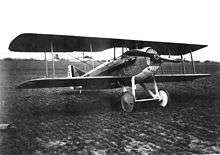
The S.XIII was of similar layout to the S.VII, i.e. a single engined biplane [nb 1] of mainly wooden construction with fabric covering,[8] but was generally larger and heavier. It was armed with two Vickers machine guns with 400 rounds per gun, replacing the single gun of the earlier aircraft.[9] The powerplant was a geared Hispano-Suiza engine, at first a 8Ba providing 200 hp (150 kW),[9] but in later aircraft a high-compression 8Bc or 8Be delivering 220 hp (160 kW).[10] The sum of these improvements was a notable improvement in flight and combat performance. It was faster than its main contemporaries, the British Sopwith Camel and the German Fokker D.VII, and its relatively higher power-to-weight ratio gave it a good rate of climb. The SPAD was renowned for its speed and strength in a dive, although the maneuverability of the type was relatively poor and the aircraft was difficult to control at low speeds: needing to be landed with power on, unlike contemporary fighters like the Royal Aircraft Factory SE.5 which could be landed with power off.[7]
While giving the Spad XIII outstanding performance, the geared engines proved to be unreliable, suffering from poor lubrication and vibration. This significantly and severely affected serviceability, with it being stated in November 1917, that the Spad S.XIII was "incapable of giving dependable service". Even in April 1918, an official report stated that two-thirds of the 200 hp SPADs were out of use at any one time due to engine problems.[11] At least one US observer believed at the time that the French were giving the US SPAD XIII squadrons lower quality engines from their least favored manufacturers while keeping the best for themselves. The problems with the engine were considered a worthy price to pay for the improved performance, however,[12] and as time went by, improved build quality and changes to the engine design led to increased serviceability.[13]
In the last few months of the war, fearing a shortage of Vickers guns, US Spad XIII squadrons began replacing their Vickers .303 machine guns with .30/06-calibre Marlin M1917 and M1918 aircraft machine guns.[14][15] By the end of the war about one half of the aircraft in US service had been converted.
Operational history
The SPAD S.XIII first flew on 4 April 1917,[9] with deliveries to the French Air Service starting in the next month.[16] The new fighter played an important part in the French plans for its fighter force, being expected to replace the SPAD S.VII, as well as the few remaining Nieuport fighters in front line service. Deliveries were much slower than expected, however, with 764 delivered by the end of March 1918 compared with a planned 2,230.[17] The S.XIII eventually equipped virtually every French fighter squadron, 74 Escadrilles using the SPAD during the First World War.[18] At the end of the war, plans were underway to replace the S.XIII with fighters using the 300 hp (220 kW) Hispano-Suiza 8F, such as the Nieuport-Delage NiD 29, the SPAD S.XX and the Sopwith Dolphin II,[19] but the SPAD S.XIII remained in service with France as a fighter until 1923.[14] Other Allied forces were quick to adopt the new fighter as well, with SPAD XIIIs equipping 15 of the 16 operational American pursuit squadrons at the Armistice. Nearly half of the 893 purchased for the United States Army Air Service were still in service in 1920. After the war, it was also exported to Japan, Poland and Czechoslovakia. In the United States, some SPAD XIIIs were re-engined with 180 hp Wright-Hispano engines to improve reliability and to prepare pilots for the new Thomas-Morse MB-3 fighter (which used SPAD-type wings in its construction) in 1922.
The S.XIII was flown by famous French fighter pilots such as Georges Guynemer and Rene Fonck, and also by Italian ace Francesco Baracca. Aces of the United States Army Air Service who flew the Spad XIII include Eddie Rickenbacker (America's leading World War I ace with 26 confirmed victories) and Frank Luke (18 victories).
In December 1917, No 23 Squadron of the Royal Flying Corps equipped with the SPAD S.XIII, retaining them until April 1918 when it re-equipped with the Sopwith Dolphin, while No. 19 Squadron (officially equipped with the earlier S.VII) also operated at least one SPAD S.XIII.[20]
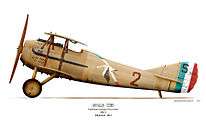 SPAD XIII Georges Guynemer
SPAD XIII Georges Guynemer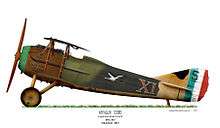 SPAD XIII René Fonck
SPAD XIII René Fonck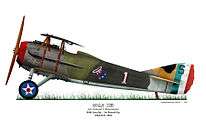 SPAD XIII Edward Rickenbacker
SPAD XIII Edward Rickenbacker SPAD XIII David "Duffy" Lewis
SPAD XIII David "Duffy" Lewis
Operators
- Argentine Air Force – Two aircraft.
- Czech Air Force – Postwar.
- Finnish Air Force – One aircraft.
- Polish Air Force (Postwar)
- Soviet Air Force – Taken over from the Imperial Russian Air Force.
- Royal Flying Corps[21]
- No. 19 Squadron RFC – One aircraft
- No. 23 Squadron RFC – December 1917 – May 1918.
Surviving aircraft
Belgium
- SP49 – SPAD XIII C.1 on static display at the Royal Museum of the Armed Forces and Military History in Brussels.[22]
France
- 4377 – SPAD XIII C.1 airworthy with the Memorial Flight Association in La Ferté-Alais, Île-de-France.[23][24]
- S5295 – SPAD XIII C.1 on static display at the Musée de l’air et de l’espace in Paris, Île-de-France.[25]
United Kingdom
- Replica – SPAD XIII on static display at the American Air Museum of the Imperial War Museum Duxford in Duxford, Cambridgeshire. It was built in Germany in the 1960s and is painted as a SPAD XIII flown by Eddie Rickenbacker.[26][27]
United States
- 7689 Smith IV – SPAD XIII on static display at the National Air and Space Museum in Washington, D.C.[28][29]
- 16594 – SPAD XIII C.1 on static display at the National Museum of the United States Air Force in Dayton, Ohio. It is painted to represent Eddie Rickenbacker's aircraft.[30]
- Composite – SPAD XIII on static display at Phoenix Sky Harbor International Airport in Phoenix, Arizona. It was previously on display at the Champlin Fighter Museum.[31] It was restored and hung by GossHawk Unlimited.[32] It includes parts from three different aircraft and is painted to represent a SPAD XIII flown by Frank Luke.[33]
Specifications (SPAD S.XIII)
Data from Fighter: The World's Finest Combat Aircraft – 1913 to the Present Day[2][34]
General characteristics
- Crew: 1
- Length: 6.25 m (20 ft 6 in)
- Wingspan: 8.25 m (27 ft 1 in)
- Height: 2.60 m (8 ft 6.5 in)
- Wing area: 21.1 m² (227 ft²)
- Empty weight: 566 kg (1,245 lb)
- Loaded weight: 856 kg (1,888 lb)
- Max. takeoff weight: 845 kg (1,863 lb)
- Powerplant: 1 × Hispano-Suiza 8Be 8-cylinder vee-type, 220 hp (164 kW)
Performance
- Maximum speed: 218 km/h (117 knots, 135 mph) at 2,000 m (6,560 ft)
- Range: 276 km (171 mi) ()
- Service ceiling: 6,650 m (21,815 ft)
- Rate of climb: 2 m/s (384 ft/min)
- Wing loading: 40.56 kg/m² (8.31 lb/ft²)
Armament
- Guns: 2 x .303-cal. (7.7 mm) Vickers machine guns or 2 x Marlin M1917 or M1918 machine guns
See also
- Early Bird Spad 13, a homebuilt replica of the SPAD S.XIII
- Related development
- Aircraft of comparable role, configuration and era
References
Notes
Citations
- ↑ Winchester 2006, p. 23.
- 1 2 Sharpe 2000, p. 272.
- ↑ Bruce Air Enthusiast Fifteen, pp. 58–60.
- ↑ Bruce Air International May 1976, p. 240.
- ↑ Bruce Air Enthusiast Fifteen, pp. 61–62.
- ↑ Bruce Air International May 1976, pp. 240–242.
- 1 2 Andrews 1965, p. 6.
- ↑ Andrews 1965, pp. 7–8.
- 1 2 3 Bruce Air International June 1976, p. 289.
- ↑ Bruce Air International June 1976, p. 292.
- ↑ Bruce Air International June 1976, p. 291.
- ↑ Bruce Air International June 1976, p. 293.
- ↑ Bruce et al. 1969, p. 9.
- 1 2 Bruce Air International June 1976, p. 312.
- ↑ Maurer 1978, pp. 146–147.
- ↑ Bruce Air International June 1976, p. 280.
- ↑ Bruce Air International June 1976, pp. 290–291.
- ↑ Bruce Air International June 1976, pp. 293–294.
- ↑ Bruce Air International June 1976, p. 310.
- ↑ Bruce 1982, pp. 561–563.
- ↑ Bruce 1982, pp. 561–564.
- ↑ "Airframe Dossier – Societe Pour lAviation et ses Derives (SPAD)XIII, c/n SP-49". Aerial Visuals. AerialVisuals.ca. Retrieved 11 May 2017.
- ↑ "Spad XIII C1". Memorial Flight. Retrieved 11 May 2017.
- ↑ "Immatriculation des aéronefs [F-AZFP]" (in French). Retrieved 12 May 2017.
- ↑ "Airframe Dossier – Societe Pour lAviation et ses Derives (SPAD)XIII, s/n S5295 RAF, c/n S5295". Aerial Visuals. AerialVisuals.ca. Retrieved 11 May 2017.
- ↑ "SPAD XIII Replica". Imperial War Museums. Retrieved 11 May 2017.
- ↑ "Airframe Dossier – Societe Pour lAviation et ses Derives (SPAD) XIII (replica), c/n 0035, c/r G-BFYO". Aerial Visuals. AerialVisuals.ca. Retrieved 11 May 2017.
- ↑ "Spad XIII "Smith IV"". Smithsonian National Air and Space Museum. Retrieved 11 May 2017.
- ↑ "Airframe Dossier – Societe Pour lAviation et ses Derives (SPAD)XIII, s/n 7689". Aerial Visuals. AerialVisuals.ca. Retrieved 12 May 2017.
- ↑ "SPAD XIII C.1". National Museum of the US Air Force. 7 April 2015. Retrieved 11 May 2017.
- ↑ "Airframe Dossier – Societe Pour lAviation et ses Derives (SPAD) XIII (replica), c/n S15155, c/r NX3883F". Aerial Visuals. AerialVisuals.ca. Retrieved 11 May 2017.
- ↑ "S.P.A.D. XIII". GossHawk Unlimited. Retrieved 12 May 2017.
- ↑ "SPAD XIII World War I Aircraft at Phoenix Sky Harbor". YouTube. 6 April 2017. Retrieved 12 May 2017.
- ↑ Winchester 2006, p. 18.
Bibliography
- Andrews, C.F. Profile No 17: The SPAD XIII C.1. Leatherhead, Surry, UK: Profile Publications, 1965.
- Bruce, J.M. The Aeroplanes of the Royal Flying Corps (Military Wing). London: Putnam, 1982. ISBN 0-370-30084-X.
- Bruce, J.M. "The First Fighting SPADs". Air Enthusiast, Issue 15, April–July 1981, pp. 58–77. Bromley, Kent: Pilot Press. ISSN 0143-5450.
- Bruce, J.M. "Spad Story: Part One". Air International, Vol. 10, No. 5, May 1976, pp. 237–242. Bromley, UK: Fine Scroll.
- Bruce, J.M. "Spad Story: Part Two". Air International, Vol. 10, No. 6, June 1976, pp. 289–296, 310–312. Bromley, UK: Fine Scroll.
- Bruce, J.M., Michael P. Rolfe and Richard Ward. AircamAviation Series No 9: Spad Scouts SVII–SXIII. Canterbury, UK: Osprey, 1968. ISBN 0-85045-009-8.
- Maurer, Maurer, ed. The U.S. Air Service in World War I: Volume I: The Final Report and a Tactical History. Washington, D.C.: The Office of Air Force History, USAF, 1978.
- Sharpe, Michael. Biplanes, Triplanes, and Seaplanes. London: Friedman/Fairfax Books, 2000. ISBN 1-58663-300-7.
- Winchester, Jim. Fighter: The World's Finest Combat Aircraft – 1913 to the Present Day. New York: Barnes & Noble Publishing, Inc. and Parragon Publishing, 2006. ISBN 0-7607-7957-0.
External links
| Wikimedia Commons has media related to SPAD S.XIII. |
- Air Force Association Fact Sheet (pdf)
- Spad S. XIII shown in Belgique maximum card
- Spad XIII in the United States Air Service with pursuit group histories
- The NMUSAF's SPAD S.XIII Page